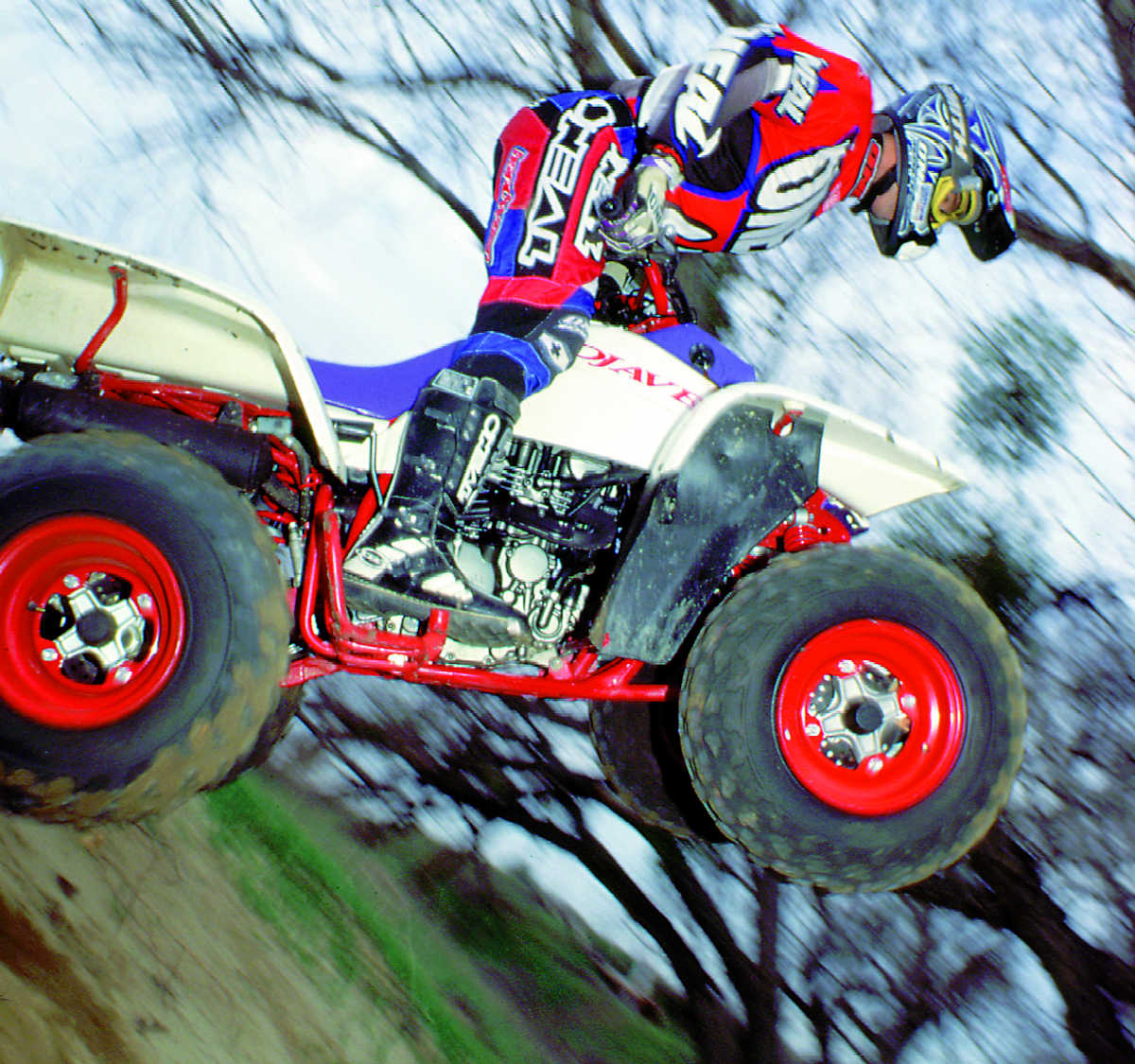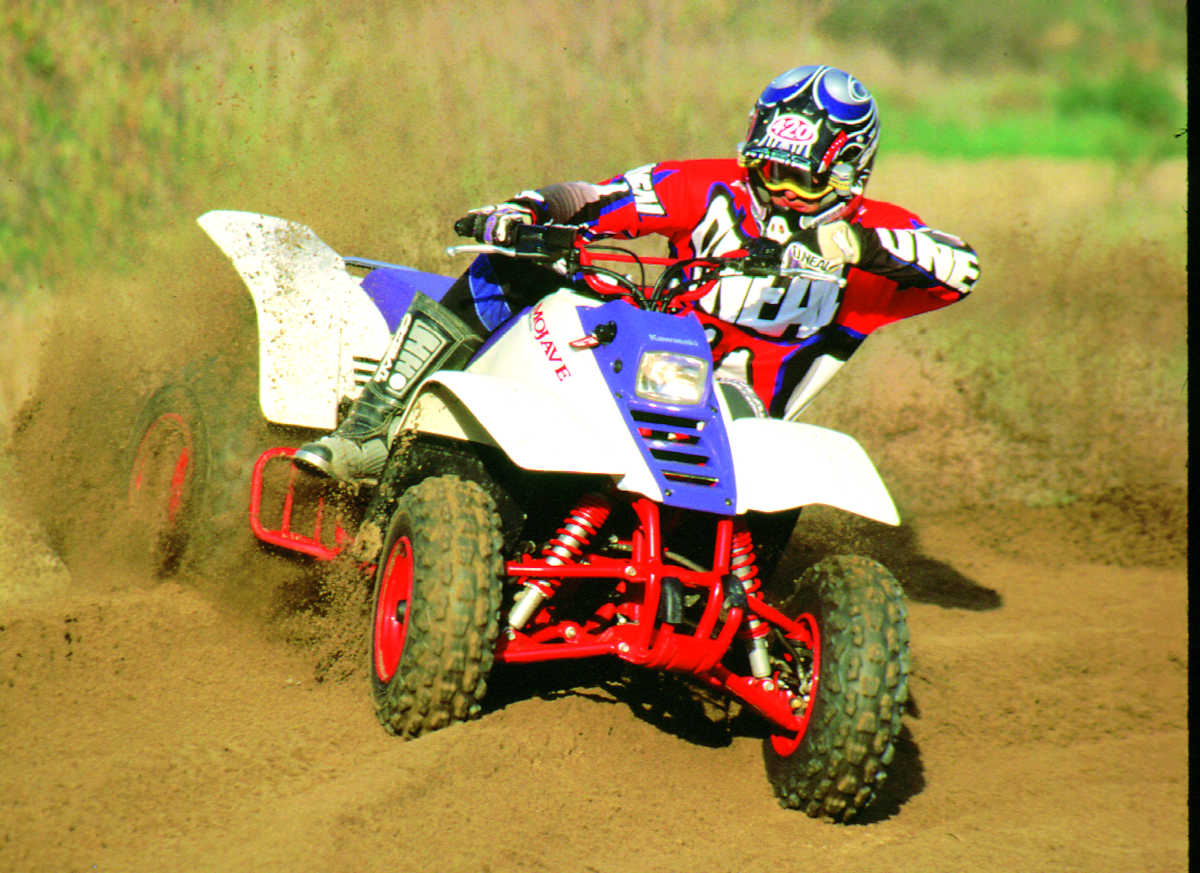RETRO TEST: MOJAVE 250: Thrilling Fun-mobile
1998 Kawasaki Mojave 250
Many new sport and high-performance quad models got their start in the bonanza year of ’87. Since then, only a few more “just-for-fun” four-wheelers have come our way.
Some, though, like the Yamaha Banshee 350 and Kawasaki Mojave 250, are still going strong well past their ten-year anniversary. https://dirtwheelsmag.com/tag/kawasaki-mojave/
As far as Kawasaki goes, the Mojave has stood as its only sport or a high-performance machine for nearly that same amount of time (the two-stroke Tecate-4 250 was also offered for a couple of years in the late ’80s).
Basically, the Mojave has gone unchanged for that span of time except for an occasional improvement. The model year ’98, in fact, sees no changes at all from ’97 (not even graphics or color!), but there is a very welcome price decrease.
The Mojave now has a manufacturer’s suggested tag of $3999 (the same as in ’95), which is $350 less than last year.
Dollar-wise, the Mojave is $800 and $950 less than its main competitors, the Honda FourTrax 300EX and Yamaha Warrior 350, respectively. However, it is still $1000 more than the Yamaha Blaster 200 two-stroke.
Despite its veteran status, the Mojave still has some unique features when compared to other sport quads.
As far as the all-important fun factor goes, well, it’s certainly still there, and considering all the heavy 4x4s the Dirt Wheels staff tests every month, we ain’t complaining about throwing a leg over our old buddy the Mojave for yet another go-around.
UNIQUE ENGINE

What sets the Mojave apart from the rest of the sport machines is the engine. It is the only sport four-stroke with water cooling, four valves and double overhead cams. The four valves are designed to allow the engine to breathe better and the dual cams permit better control over the timing of the opening and closing of the valves, which can result in increased horsepower. Liquid cooling keeps the motor operating at relatively low temperatures (and with maximum horsepower) and is easier on all the engine components.
The 249cc powerplant is fed by a 34mm Keihin CVK carburetor. It has a claimed torque/rpm ratio of 16.6 ft./lb.@7500 rpm and a top speed of over 60 mph. To start it, there’s a forward-kick kickstarter.
SPORTY TRAITS
A manually clutched five-speed tranny with reverse is used, and final drive is a conventional chain/sprocket arrangement. Two five-way preload-adjustable shocks in the front offer 6.9 inches of wheel travel, which is typical for a sport machine. In the rear there’s a five-way preload-adjustable gas shock mounted directly to the swingarm without any linkage, putting out 8.5 inches of wheel travel.

Triple hydraulic disc brakes provide the stopping power for the 379-pound machine (claimed dry weight). A single 12V, dual-level, 45-watt headlight is frame-mounted upfront.
TRAIL TEST
For quite a few years now, we have not been particularly happy with the starting characteristics of the Mojave. The forward Kickstarter bottoms out on the footpeg during a good kick (sometimes painfully). The machine rarely starts on the first kick. You are really in for some frustration if you happen to flood it as well.
Once you get the quad fired up, the sound from the exhaust isn’t bad at all. Our test machine idled smoothly, and right off the bat, we could tell that the Mojave delivers great throttle response from the peppy engine. Shifting through the gears went pretty smoothly, but riders with big feet may have trouble getting underneath the lever.
Speaking of rider size, this is one of the most telling aspects of the Mojave. This machine fits smaller, lighter riders much better than the big boys. If you are taller than 6’0”, or a large-framed 5’9”, you will probably feel cramped on the compact Mojave, especially when turning.

Thrilling Fun-mobile
Out on the trail, of course, is where the fun kicks in. We have always liked the turning and handling characteristics of the Mojave, especially on tight, wooded trails. The machine feels maneuverable and light (although it’s actually quite heavy for a sport machine) on tight trails, and the power delivery is smooth and predictable. Turn up the throttle and have even more fun! This truly is a thrilling fun-mobile to ride.
For most trail obstacles, both the front and rear suspension do a good job of soaking up the hits. However, the Mojave comes up short (literally!) when tackling big whoops. That’s when the combination of a heavy four-stroke engine in a fairly short frame results in a bouncy, swapping ride. Some testers also thought that both the front and rear shocks are oversprung, giving them a choppy ride on uneven or rocky terrain.
The Mojave’s jumping abilities, however, got good marks from all of our testers. It was fun to leap and did nothing weird while airborne or upon landing. Of course, just like any other quad, it has jumping height limitations, but the price of overdoing it isn’t that bad.
Thrilling Fun-mobile
The only downfall in the engine department was the sluggish sign-off at the top end of the powerband. This is due to an overcautious rev limiter. However, the low-end and midrange power received high marks and the machine has plenty of grunt for most hills and steep banks.
From the control end, we all liked the smooth feel of the clutch and the brakes, which only add to the fun factor. The Mojave is a good slider, and wheelies can easily be popped to skim trail obstacles or just for fun.
Shifting into reverse is a fairly easy procedure, unlike some of the other sport quads. All you have to do is have the machine in first or neutral, pull in the clutch, turn the reverse knob on the dash and depress the shifter. There’s a reverse indicator light on the dash so you know exactly when it’s engaged.
GARAGE CHORES & ACCESSORIES
Along with checking the coolant level, the Mojave only needs the occasional air filter cleaning, oil, and oil filter changing, and valve clearance check. Kawasaki recommends sending your Mojave to a dealer to check the clearance on the valves, but an experienced home mechanic with a service manual and a decent set of tools can get the job done.
Thrilling Fun-mobile
The engineers who developed this machine appear to have done everything right as far as the oil system goes. The oil-level sight gauge is easy to read and right next to the footpeg. The drain plug is easy to get to and seems to be well protected. The filler cap is easy to use and changing the oil filter is a snap.
On the other hand, the air filter system is not so hot. You have to remove the plastic fenders with tools just to get to it, then you have to deal with six screws to get the wimpy filter off.
The chain adjustment system is simple and foolproof. Other detail work is pretty good, such as the handlebar-mounted choke knob, fuel petcock, parking brake, and access to the cooling system.
OEM Kawasaki accessories for the Mojave include front and rear racks (yes, it is capable of work!), floorboard extenders (kind of like racing nerf bars), headlight, and taillight guards, and a front glide plate. Of course, there are many other aftermarket products such as performance exhaust pipes, racing cams, big-bore kits, and full skid plates.
FINAL THOUGHTS
If going fast, jumping, sliding and popping wheelies are your main goals out on the trails, then the ’98 Kawasaki Mojave 250 certainly can deliver the goods.
We especially enjoyed its agile handling, strong engine, and decent suspension. However, after 12 years with very few changes, we can understand why trailriders are screaming for even more power and suspension, especially since this has been the lone sport offering from Kawasaki for quite some time.
Perhaps the fact that there were no changes from the ’97 model is a signal that Kawasaki may be ready to switch gears in the sport market, but that could still be a couple of years off.
For now, riders who hit the trails simply for the joy of it can take advantage of a ’95 price tag on a new Mojave right now.
- 1998 Kawasaki Mojave
- Engine type: Liquid-cooled, 4-valve, DOHC 4-stroke
- Displacement 249cc
- Bore and stroke 74mm x 58mm
- Carburetion 34mm Keihin CVK
- Claimed torque/rpm 16.6 ft./lb. @7500 rpm
- Starting Primary kick
- Starting procedure Forward kick, in neutral or any gear with the clutch disengaged
- Transmission Manual clutch, manual shift, 5-speed with reverse
- Final drive 520 O-ring chain
- Fuel Capacity 2.2 gal.
- Wheelbase 42.3”
- Overall length/width/ height 68.3”/43”/40.8”
- Seat height 29.7”
- Ground clearance 8.5”
- Claimed dry weight 379 lb.
- Suspension/wheel travel:
- Front Dual A-arms with twin five-way preload-adjustable KYB shocks/6.9”
- Rear Swingarm with linkage to single five-way preload-adjustable KYB gas shock/8.5”
- Brakes/actuation:
- Front Twin hydraulic discs/right-hand lever
- Rear Single hydraulic disc/right foot pedal
- Tires:
Front Dunlop KT846 AT21x7-10
Rear Dunlop KT847M AT22x10-10 - Suggested retail price $3999
-
To subscribe to Dirt Wheels Magazine in print or digital form click here https://hi-torque.com/product/dirtwheels
![]()








Comments are closed, but trackbacks and pingbacks are open.